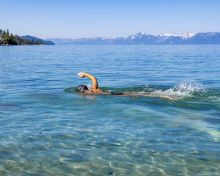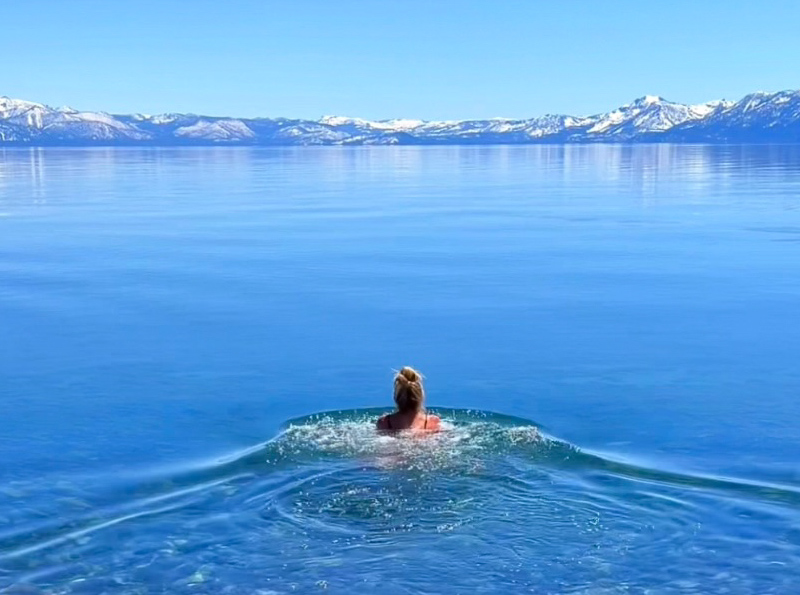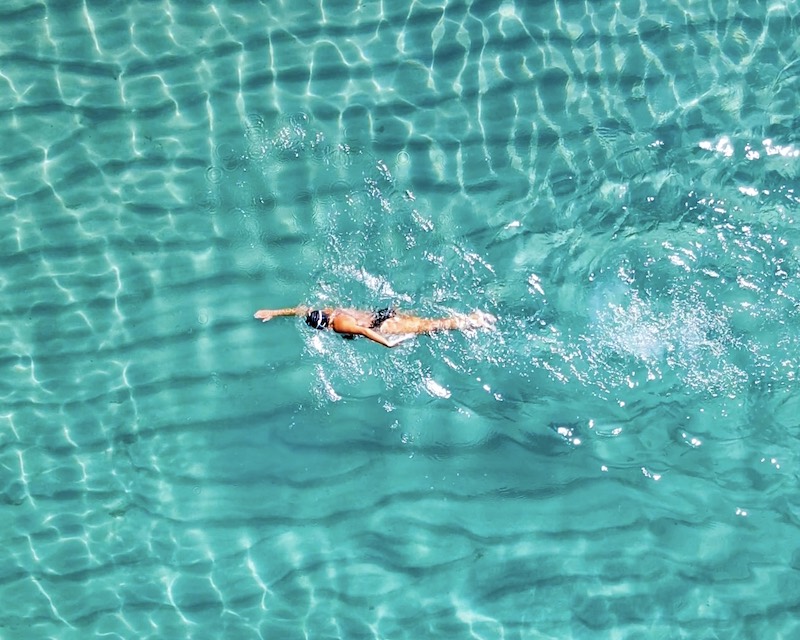
As temperatures steadily rise around the Tahoe-Truckee region, locals and prospective visitors eagerly prepare to travel to the “Caribbean of the Sierras.” Lake Tahoe, the largest and most visited lake in the region, is truly an alpine summer paradise with an endless supply of adventures and recreational activities for everyone to enjoy. Swimming, boating, kayaking and paddleboarding are quintessential Tahoe summer activities and help create fond memories. I’m a firm believer that no Tahoe trip is complete without some quality beach and swimming time!
Lake Tahoe’s crystal-clear blue and turquoise waters draw large numbers of visitors from around the globe annually. But don’t let appearances fool you: The water is a lot colder than it looks! And although it is tempting, and quite refreshing, to cool off and swim on a hot summer’s day, there are also plenty of risks that come with recreating in cold and deep water.
Even the strongest and most experienced swimmers can find themselves at risk when conditions suddenly and unexpectedly change, or if they miscalculated the temperature, depth and distance from shore.
Incidents and accidents happen annually, and although many don’t end in tragedy, unfortunately, many still do. Hypothermia, cold-water shock, cardiac issues, disorientation and drowning are all too common. It’s important to understand the risks, be honest with your abilities, respect the lake and take action to gain the knowledge necessary to identify hazards and be a strong and competent open water swimmer. It’s also important to know how to react should anything unexpected occur, and this can save your life. Remember: Don’t panic!
Below I have outlined five tips to help you stay safe this summer and enjoy Lake Tahoe and other alpine lakes in the region to the fullest!

Be mindful of how your body reacts to cold temperatures as you enter the water. Photo Credit: Kirsten Alexis
Understand the Risks of Swimming in Cold Water
Although the sparkling waters of Lake Tahoe resemble a postcard from the tropics, the water is quite cold year-round, especially once you leave the shallow shores. As the second deepest lake in the United States, Lake Tahoe can present numerous hazards to swimmers and recreationalists depending on location, conditions and personal awareness and abilities.
Designated shallower areas tend to be warmer and calmer and thus are safely encouraged for recreation, especially for families, younger children, pets and first-time Tahoe swimmers. But don’t get too confident! As you maneuver into deeper areas, the water drastically changes, often dipping into temperatures in the 50s and even 40s. Aside from temperature and depth changes, open waters present rougher currents, which can cause emergencies once a swimmer fatigues or panics.
Open water swimming affects everyone differently, and it’s important to not only be educated about the risks, but also understand how it affects you personally. Some tips I have are to test the water slowly so you not only acclimate, but also experience firsthand how the temperature and conditions affect you. For some people, the cold temperature can cause an initial shock reaction, especially if they jump in or walk in too quickly. Be mindful and take it slow as you walk in (feet first is always the safest protocol).
Also be aware of current conditions, your swimming ability and safety protocols and emergency plans should the worst case occur. I always advise looking at the weather forecast (air and wind temperatures) and the water forecast for the location you will be in. Also, make sure to research if there are lifeguards present, as well as any potential hazards, locations of designated safe swimming areas and local emergency contacts.
Keep in mind that when you are inside designated swimming areas, you are typically inside buoys that signify to boaters to slow down. Once outside, you are even more responsible for your own safety. Always be aware of your surroundings and make your presence known.
Know How to Swim in Open Water and Know Your Limits
Open water swimming is very different than swimming in a pool, and even the best swimmers can face various challenges due to constantly changing conditions. This can affect the core body temperature, stroke length and rate, mental clarity and perception.
While it is imperative to have strong swimming skills, most commonly learned in the pool, it is also important to have safety and survival skills as well. These include floating, rhythmic breathing, treading water and navigational skills. Water rescue, CPR and basic first aid are highly recommended and can be taken at a local pool facility in a lifeguard skills course.
Always have a plan and stay in designated swimming areas. Have floatation devices or a whistle on you and a bright swim cap or personal buoy so you are recognizable by recreational boaters. Besides being responsible for your own safety with temperatures and currents, you also need to ensure that you can be seen by others and contain potential hazards and threats. Remember, even though you can see them, many boaters cannot see you.
Make a slow entry into the water and go feet first. Many times, people misread the depths of the water and obtain head and neck injuries from diving. A slow walk-in entry also helps you acclimate to the water and avoid shock. Keep a steady pace and breath and stop when needed to tread water, float or re-orient yourself. Consistent and honest check-ins are key.
If you don’t feel comfortable in open water, I suggest hiring a coach to help you get more confident and build strength and skills. This can be done in both the pool and lake and under supervision. This is especially helpful if you don’t have swim partners.
And most importantly, trust your instincts. If you feel uneasy or unsure of continuing your swim, stop, take a breath and head back. The best piece of advice I can give is “when in doubt, get out!”

Have a Buddy System: Never Swim Alone
Being prepared to swim in open water goes beyond skills and knowledge of the forecast. It also means knowing that swimming alone can lead to tragedy and that having other people around that you trust not only holds you accountable, but also makes the experience more enjoyable. Even if there are lifeguards and park rangers nearby, they can’t see or respond to everything, especially if you are a long distance offshore.
Having a swim partner or group is essential should conditions change or injuries occur. It is important that prior to your swim, you come up with a plan and backup plans. Each swimmer should be confident in their abilities to be a strong swimmer and also provide assistance and alert for help. Having peace of mind knowing that you are safe with other responsible people makes the experience more enjoyable.
And make sure to be a “buddy” to other swimmers in the vicinity, should you see them in distress or in an area that may present potential risks or hazards. Looking out for each other is important and ensures that everyone can recreate safely.
Having a designated swim partner or group can also make the experience more fun and can lead to opportunities such as learning new safety and swimming skills or becoming involved in local races and community events!
Have a Life Jacket and Proper Gear
Having a life jacket, proper weather-appropriate swim attire, a personal swimming buoy and PDFs can make a difference in a life-or-death situation. These rules are typically enforced at most beaches for swimmers and other open water recreators.
Not only can the proper inflatable safety devices help prevent drowning incidents, they are also used for visibility (especially if they are bright colors), specifically with boaters and lifeguards. Should an emergency occur, floatation devices can help keep the swimmer afloat and calm.
I also recommend a wetsuit for people who plan to be in the water for a prolonged period. It provides a layer of warmth and a bit of extra buoyancy.
It is essential that life-saving devices and wetsuits are properly fitted to your body, which is “snug but comfortable.” Meaning, tight enough to fit, but also providing full range of motion.
Remember, while having a properly fitted life jacket, wetsuit and safety gear can provide an extra layer of safety, they are not to be fully relied on should emergencies occur. It’s important to have knowledge, skills and backup plans.
Come to the Lake Prepared
Now that we have covered open water knowledge, swimming skills, safety procedures and gear, it’s important to cover preparation for the day ahead to ensure you enjoy it to the absolute fullest.
With heat and high altitude, dehydration can occur faster than you think. It’s important to bring enough water (I also bring electrolytes) for the day and activity. I also recommend bringing a healthy and hearty meal and snacks to enjoy afterwards. Nothing hits better than a meal after a long workout!
Make sure you wear enough SPF and reapply frequently. Be aware of how you are feeling in the heat and sunshine. Heat-related health problems can arise, such as heat stroke, and it’s important to be aware of how you are feeling throughout the day. Do self-checkups and make sure to get to a shaded area or leave should you start to feel symptoms.
Don’t drink alcohol or take substances before you swim, as these can seriously impair your judgement.
Have emergency procedures and hotlines with you. Know where the lifeguards are and assess the area for potential hazards and landmarks you can look out for when in the water.
Leave no trace! Remember, we all share the lake and land together.


 Kirsten is an outdoor adventure enthusiast, writer and photographer. You can typically find her hiking, paddleboarding, cross-country skiing and checking out new spots to share in the Tahoe Donner region. She has been lucky to call Tahoe her second home since she was a child and aims to inspire people to experience Tahoe and fall in love with the beauty and adventurous spirit of the region through her blogs and content.
Kirsten is an outdoor adventure enthusiast, writer and photographer. You can typically find her hiking, paddleboarding, cross-country skiing and checking out new spots to share in the Tahoe Donner region. She has been lucky to call Tahoe her second home since she was a child and aims to inspire people to experience Tahoe and fall in love with the beauty and adventurous spirit of the region through her blogs and content. 






